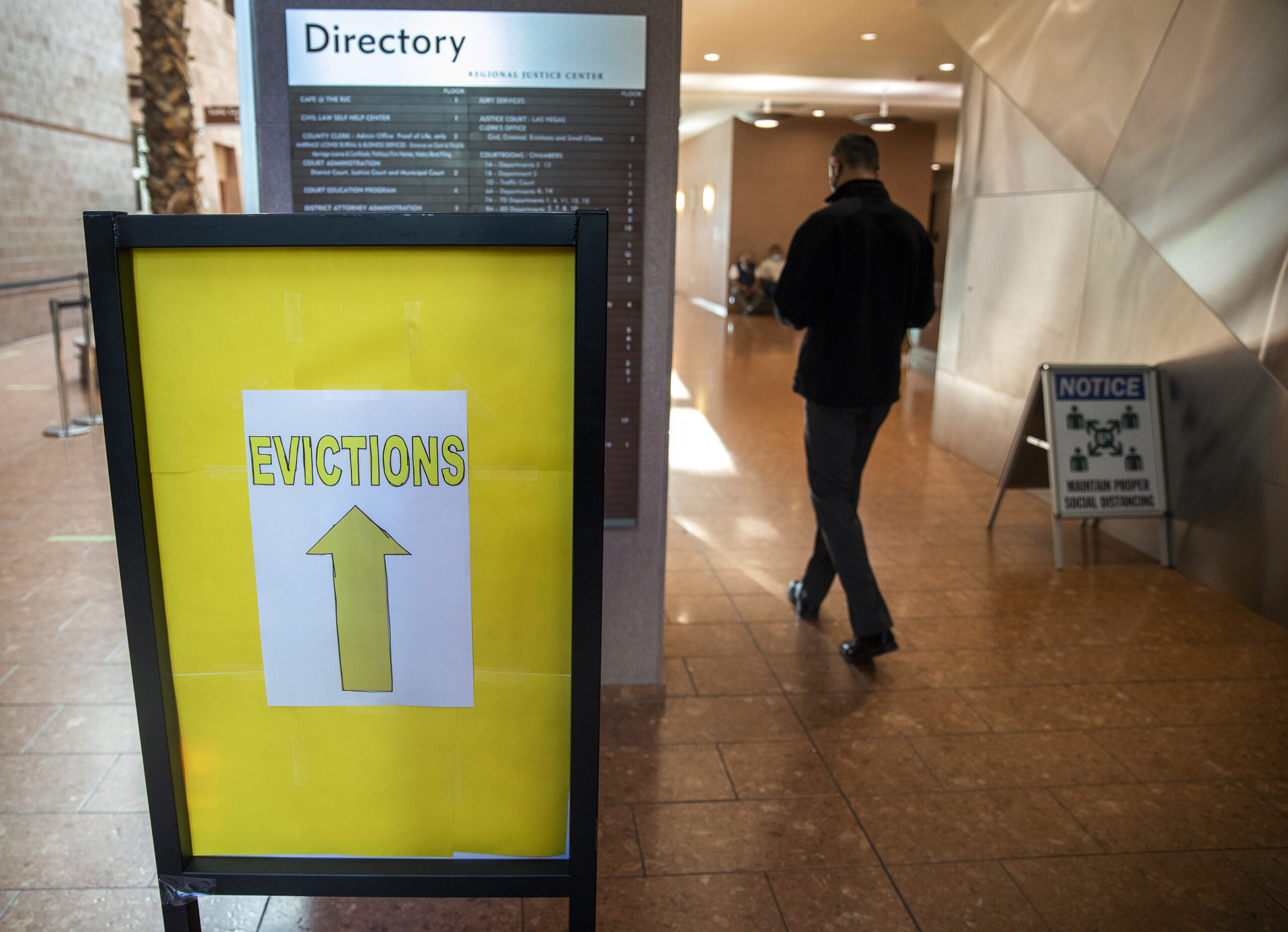Housing insecurity: A slow burn crisis we must continue to manage

As July 31 approached, policymakers and journalists were madly trying to pin down estimates of how many Nevadans might be affected when the federal and state eviction moratoria that had been in place (for the most part) since March 29, 2020 expired. Despite strong signs that many parts of Nevada’s economy are recovering, tenants and landlords are still hurting. Will Nevada face a rapid wave of evictions in the months ahead? Unfortunately, we do not know with any degree of certainty how many Nevadans will be affected once the eviction moratoria expire. Recent data and the continuation of effective assistance programs provide some comfort that Nevada may not experience a crisis-level surge of evictions in the short-term, but historical information portends that Nevada could face an increase in evictions once the economy starts to expand.
First, the good news.
1. The number of households likely facing eviction has declined over the past 12-15 months. Figure 1 plots household survey data collected by the U.S. Census Bureau at regular intervals. As seen, the number of households indicating that they are behind on rent and/or face eviction has steadily declined since the Census Bureau began collecting data. At the end of December 2020, roughly 117,000 renter households in Nevada said that they were not caught up on rent and 80,000 households said that they were likely to be evicted from their home within the next two months. By the end of June 2021, however, the number of renter households who stated that they were not caught up on rent had fallen to 65,000, and those who said they were likely to be evicted within the next two months had decreased to 51,000.
A more recent analysis by Surgo Ventures indicates that, as of July 5, 59,400 households in Nevada were behind in rent (including 47,000 in Clark County and 8,000 in Washoe County). The average amount owed by renter households in Clark County is $4,245 and $3,901 in Washoe County. Delinquent households owe $30.2 million in Washoe County and $197.0 million in Clark County for a statewide total of $235.3 million. This is a significant decrease from December 2020 when roughly 93,802 renter households were in arrears and total rental debt owed in Nevada was $353.4 million.
Figure 1. U.S. Census Bureau Household Pulse Data on Renter Households in Nevada, 2020-2021
2. The decline in eviction risk suggests that state and federal policy interventions have been successful. As the pandemic continued to wreak havoc on businesses and families, Washington responded with financial assistance programs (including unemployment benefits) and an eviction moratorium. Nevada launched rental assistance programs, its own eviction moratorium, and a new eviction mediation program. Collectively, the data suggest these programs, along with continued economic recovery, have provided significant housing stability to many Nevada families and landlords.
By way of example, Clark County alone has distributed roughly $162 million in rental and utility assistance to about 90,000 households in Southern Nevada. (As a side note, last July, the Guinn Center projected that 113,000-136,000 renter households in Nevada might face eviction by the end of the year.) While the slow pace of processing rental assistance applications has been met with frustration, Nevada’s government agencies appear to be disbursing their precious resources to those areas of greatest need. In Figure 2 below, the map on the left side indicates the geographic areas with the greatest need of emergency rental assistance in Clark County. The darker areas represent areas of greatest need. The map on the right side indicates the distribution of Clark County CARES Housing Assistance Program (CHAP) rental assistance in Clark County (as of March 2021). The darker areas reflect a higher percentage of households receiving rental assistance. Viewed together, the maps indicate that Clark County, despite the processing challenges, has done an excellent job directing rental assistance funds to the areas of greatest need. (We attempted to replicate this map for Washoe County and Nevada’s rural counties, but data limitations and scaling issues prevented us from doing so).
Figure 2. Emergency Rental Assistance Need and Households Receiving Rental Assistance, Clark County
3. A full-blown evictions crisis is likely to be averted given the continued operation of existing and effective programs and the recent legislative adoption of several new policy measures. First, as Governor Sisolak recently stated, there is “plenty of rental assistance money available.” Assembly Bill 486 “ensures both landlords and tenants will receive the benefit of $360 million in federally funded rental assistance to keep people in their homes and prevent unnecessary evictions.” (Recall that one estimate puts Nevada’s current rental debt at $235 million). One of the features of Assembly Bill 486 is that, as of Aug. 1, landlords can apply directly for rental assistance to cover tenants who have not applied for assistance. (Typically, tenants are responsible for applying for rental assistance, which is then directly paid to landlords). The eviction mediation program continues to process an increasing number of cases as awareness about the program grows. In addition, Assembly Bill 141 now requires the automatic sealing of records for certain summary evictions relating to defaults in the payment of rent which are granted during the COVID-19 emergency. The ongoing challenge will be to ensure agencies have the human capacity and the information technology infrastructure to process rental assistance applications and mediation cases in a timely manner.
Now, the not-so-good news and the potential crisis to be managed.
Historical data hint that Nevada may not be able to permanently stave off an evictions crisis. As shown in Figure 3, during the Great Recession (2008-2009), eviction filings decreased as the unemployment rate increased. This same pattern bears out with the COVID-19 pandemic: according to Eviction Lab, Clark County had an estimated 22,400 eviction filings from March 15, 2020, to May 27, 2021, during which time the unemployment rate varied from 8.0 percent to 29.5 percent. This was a significant decrease from 40,909 eviction filings in 2019 when Nevada’s unemployment rate was 3.9 percent. However, as Nevada’s economy started to recover following the Great Recession and the unemployment rate fell (blue line), eviction filings ticked upward to a high of 46,872 eviction filings in 2019. The rapid increase in eviction filings was driven by Clark County. Summary evictions in Clark County (which houses 74 percent of the state’s total population) accounts for 70-88 percent of all summary evictions in Nevada. Furthermore, over the period 2000-2019, summary eviction filings increased in Nevada and Clark County by 40.0 and 92.0 percent but decreased in Washoe County (gray line) by 66.0 percent.
Figure 3. Summary Eviction Filings in Nevada, 2000-2020
If history provides any sage counsel from which Nevada’s leaders can learn and plan, it is that Nevada may experience a second wave of evictions once the economy is in full post-COVID recovery mode. Based on the post-Great Recession recovery, evictions may start to tick upwards – five to six years from now – as the economy continues to steadily expand. From a planning perspective, this means ensuring that programs are in place to support renter households and that government (and nonprofit) budgets include funds for rental assistance programs. It is important to note that the time frame of possible increases in evictions extends beyond the time American Recovery Plan funds will be available and must be expended. Moreover, given the possible housing insecurity faced by renter households as the economy continues to grow, policymakers and housing advocates in Nevada should continue to press forward on conversations and policies to rehabilitate and preserve existing affordable housing (and rental) units and expand the supply of affordable housing options.
Nevada’s political and administrative leaders have adeptly crafted and executed a series of programs and policies to reduce housing insecurity for thousands of Nevada’s renter households during this public health crisis. These planning efforts and financial commitments will likely enable Nevada to avert a full-blown evictions crisis following the expiration of the eviction moratorium. Finding ways to extend these programs and identify long-term funding sources will help Nevada plan for and avert a potential increase in evictions once the economy recovers.
Nancy Brune, Ph.D. is the founding executive director of the Guinn Center, a statewide, independent, nonpartisan policy research center. She is a senior fellow at the Boyd School of Law and serves on the Law and Leadership Program Advisory Council. Dr. Brune received her Ph.D. from Yale University and her Master of Public Policy and B.A. degrees from Harvard University. Prior to joining the Guinn Center, she was a senior policy analyst at Sandia National Laboratories, where she worked on issues of national security. You can follow her on Twitter @NancyBrune or email her at [email protected].
